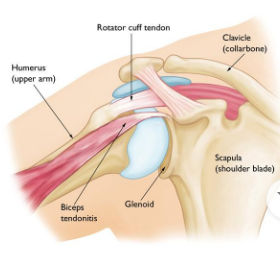Biceps Tendinitis
Biceps tendinitis is an inflammation or irritation of the upper biceps tendon.
 Pain in the front of the shoulder and weakness are common symptoms of biceps tendinitis. They can often be relieved with rest and medication. In severe cases, surgery may be needed to repair the tendon.
Pain in the front of the shoulder and weakness are common symptoms of biceps tendinitis. They can often be relieved with rest and medication. In severe cases, surgery may be needed to repair the tendon.
Biceps tendinitis is an inflammation or irritation of the upper biceps tendon. Also called the long head of the biceps tendon, this strong, cord-like structure connects the biceps muscle to the bones in the shoulder.
Your shoulder is a ball-and-socket joint made up of three bones: your upper arm bone (humerus), your shoulder blade (scapula), and your collarbone (clavicle).
- Glenoid. The head of your upper arm bone fits into the rounded socket in your shoulder blade. This socket is called the glenoid. The glenoid is lined with soft cartilage called the labrum. This tissue helps the head of the upper arm fit into the shoulder socket.
- Rotator cuff. A combination of muscles and tendons keeps your arm centered in your shoulder socket. These tissues are called the rotator cuff. They cover the head of your upper arm bone and attach it to your shoulder blade.
- Biceps tendons. The biceps muscle is in the front of your upper arm. It has two tendons that attach it to bones in the shoulder. The long head attaches to the top of the shoulder socket (glenoid).
 The short head of the biceps tendon attaches to a bump on the shoulder blade called the coracoid process.
The short head of the biceps tendon attaches to a bump on the shoulder blade called the coracoid process.
Biceps tendinitis is inflammation of the long head of the biceps tendon. In its early stages, the tendon becomes red and swollen. As tendinitis develops, the tendon sheath (covering) can thicken. The tendon itself often thickens or grows larger.
The tendon in these late stages is often dark red in color due to the inflammation. Occasionally, the damage to the tendon can result in a tendon tear, and then deformity of the arm (a “Popeye” bulge in the upper arm).
Biceps tendinitis usually occurs along with other shoulder problems. In most cases, there is also damage to the rotator cuff tendon. Other problems that often accompany biceps tendinitis include:
- Arthritis of the shoulder joint
- Tears in the glenoid labrum
- Chronic shoulder instability (dislocation)
- Shoulder impingement
- Other diseases that cause inflammation of the shoulder joint lining
For more information on symptoms and specific treatment options, visit OrthoInfo.AAOS.org
Adapted from AAOS OrthoInfo
